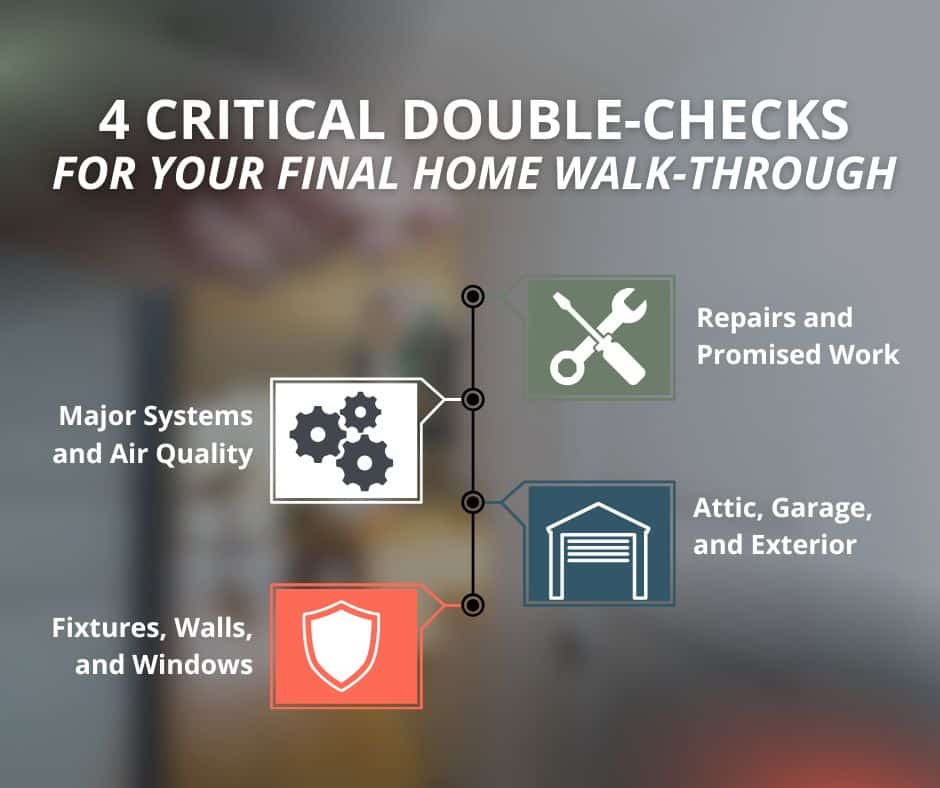Buying a home is a huge decision, and the final walk-through gives you one more opportunity to protect yourself before signing the paperwork. This quick but critical visit helps confirm the property’s condition, ensures repairs were completed, and gives you peace of mind that everything is ready.
A 2024 report from the National Association of Realtors found that more than 9 out of 10 buyers conduct a final walk-through, and around 30% of those find issues that need to be addressed before closing.
Skipping this step can mean inheriting problems that should have been caught earlier. This guide will help you get it right, note red flags to watch for, and share expert tips from Central Florida’s inspection pros.
Table of Contents
ToggleWhat Is a Final Walk Through and Why Does It Matter?
A final walk-through is your last in-person visit to the home before closing. It usually happens within a few days of your closing date. The seller should be moved out, and the home should be in the same condition (or better) than when you agreed to buy it.
This is not a full home inspection. Instead, your goal is to:
- Verify that all agreed-upon repairs are finished
- Make sure no new damage has occurred
- Confirm the home is clean, empty, and functional
- Check that fixtures and appliances are still in place
This step is especially important if repairs were negotiated after the inspection or if the property has been vacant.

What to Bring With You
Show up ready with the following:
- A printed or digital copy of your purchase agreement
- Repair request forms or addendums
- Your home inspection report
- A phone or camera to document any concerns
- A flashlight for checking attics or crawlspaces
- An outlet tester or a small device (like a phone charger)
Ask your real estate agent to walk through the home with you. They can help compare the current condition against the contract and take action if something seems off.
Full Walk Through Checklist
Take your time and go room by room. Don’t be afraid to open cabinets, flip light switches, or run water.
1. Repairs and Promised Work
- Were all the agreed-upon repairs completed?
- Do they look professionally done?
- Do you have receipts or warranties?
In Florida, where moisture intrusion and HVAC issues are common, make sure any water or mold-related repairs are truly addressed. Surface fixes that hide deeper issues can lead to costly surprises later.
2. Major Systems and Appliances
- Turn on lights, fans, and switches
- Run the dishwasher and laundry machines
- Test the stove and oven
- Flush all toilets and run water in every sink
- Check water pressure and hot water
- Confirm that smoke detectors and carbon monoxide alarms are present (and functional)
3. HVAC and Air Quality
Given Florida’s humidity, HVAC performance matters. Set the thermostat to cooling mode and confirm the unit kicks on. Listen for unusual sounds and note any weak airflow.
If repairs were made to the air handler or ductwork, look for signs of leaks or loose insulation.
4. Attic, Garage, and Exterior
- Open attic access points and inspect for pests, moisture, or leftover items
- Check that garage doors and openers function properly
- Inspect siding, gutters, and downspouts
- Look for signs of roof damage or pooling water near the foundation
Poor drainage is a top contributor to structural damage in Florida homes. Walk around the property and check that water flows away from the house, not toward it!
5. Fixtures, Walls, and Windows
- Make sure blinds, light fixtures, and ceiling fans are still installed
- Check for cracks or stains on ceilings and walls
- Open and close all windows and doors
- Look for broken locks, screens, or damaged seals
If furniture was removed before the home walk-through, look for signs that it was hiding damage. Watch out for large patches of mismatched paint or missing floorboards.

What to Do If You Find a Problem
If something minor is missing or damaged, you can request a credit or delay closing while it’s addressed. If a major repair was ignored or new structural damage is discovered, your agent can help negotiate a solution.
Do not close until everything matches the agreement. While it may delay the process, skipping this final layer of protection could cost you more in the long run.
The most common issues found during final walk-throughs include:
- Repairs not completed (or done poorly)
- Appliances swapped out or removed
- Leaks or signs of mold
- Leftover junk in garages or attics
- Damage from the seller moving out
Related Buyer Questions
How long should a final walk-through take?
Expect 30 to 60 minutes for an average single-family home. If the seller left furniture or repairs are complex, it may take longer.
Can I delay closing if I find a problem?
Yes, if the issue violates the terms of the contract. Your agent will help you document concerns and decide whether to pause closing, request a repair, or negotiate compensation.
Should I bring my inspector again?
If you’re unsure about something serious, such as signs of water damage or structural shifts, yes. A re-inspection can provide professional documentation to support your case.
When to Bring in a Professional
You don’t need a licensed inspector for every final walk-through, but in some cases, it’s smart to call for help. Contact a professional if:
- Repairs look sloppy or incomplete
- There’s evidence of roof or water damage
- You notice pest activity or droppings
- The HVAC or water heater doesn’t seem to function correctly
- You see cracks that weren’t present before
A follow-up inspection can be scheduled quickly and provide the objective report you need to delay closing or negotiate a fix.
This service is especially valuable in Central Florida, where storms, pests, and high humidity can accelerate property damage between your initial inspection and final walk-through.
Tier-1 Pro Inspections offers final walk-through consultations, post-repair inspections, and support for concerned buyers who need expert eyes before moving forward.
Final Thoughts
The final home walk-through may seem like a small step, but it can make a huge difference. This is your last opportunity to confirm that the home is truly ready for you. Walk in prepared, stay alert, and speak up if something doesn’t feel right.
Don’t rush. Don’t assume. You’ve come this far, so make sure your investment is protected.

